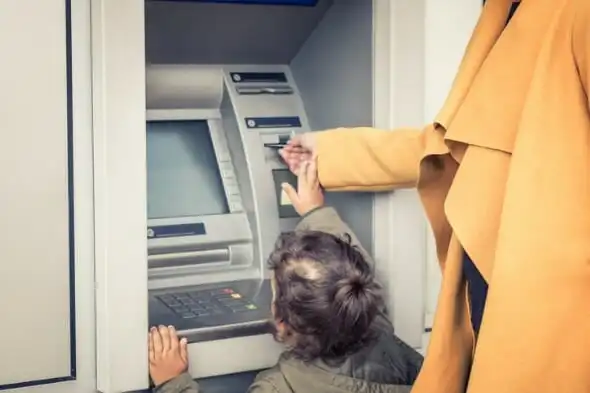When it comes to accessing your various bank accounts, ATMs offer a big convenience. This is especially true when you bank with an institution that offers thousands of ATMs all over the world. According to data from the World Bank, there were around 39 ATMs per 100,000 adults in the world in 2021. The per-capita number of ATMs has been declining in recent years, however, they are still common. Despite their geographic convenience, using an ATM can actually cost money, depending on your bank and the ATM you use.
If you’re looking for a roundup of top savings accounts on the market, check out SmartAsset’s list of the best savings accounts.
What Are Bank ATM Fees?
Bank ATM fees are just one of the many bank fees you can face. Usually, your bank won’t charge an ATM fee when you use a bank-branded machine. However, if you use an ATM outside of the bank’s network, you’ll likely face an ATM fee. This includes withdrawals, deposits and balance inquiries. This kind of ATM fee is often a flat dollar amount rather than a percentage of your transaction.
Unfortunately, out-of-network ATM transactions usually trigger two fees. First, your bank will charge you a surcharge for using a non-network machine. Second, the ATM operator will also charge a small fee. You’ll typically see this fee pop up on the ATM before you complete your transaction. While you can’t always avoid this fee, using another bank’s ATM will often be cheaper than a non-bank ATM.
Coughing up a couple dollars to use an ATM in a cash emergency is a small price to pay. However, it’s important to avoid paying these fees too often. They can easily add up and end up taking a chunk out of your savings, even if you have the right savings account. If you want to withdraw money from an overseas ATM, a whole other set of foreign transaction fees come into play.
Average Bank ATM Fees
Bank ATM fees vary based on your bank and the type of account you have. A 2025 Bankrate report found that that the average ATM fee is $4.77 per transaction.
The total fee represents a combination of charges from the bank and the ATM network. Some banks allow a certain number of out-of-network transactions to their clients. The number of free ATM transactions may vary according to the type of account as well.
Which Bank Has the Cheapest ATM Fees?

Luckily, some banks do charge well below the average in ATM fees, often waiving or reimbursing fees. For one, Capital One offers free access to 70,000 Capital One, MoneyPass® and Allpoint ATMs.
Consider EverBank, too, which reimburses you for unlimited ATM fees as long as you maintain a minimum balance of $5,000 in your Performance Checking Account.
Citi, one of the largest banks in the U.S., offers account holders access to more than 60,000 fee-free domestic ATMs. It also waives out-of-network ATM fees for Citi Priority Accounts and Citigold/Citigold Private Client. The bank has ATMs in more than 20 countries abroad, making it easy for customers to take a trip. The same high-end account holders also get to avoid the bank’s 3% foreign exchange fee.
Charles Schwab Bank offers unlimited ATM fee reimbursements worldwide. Nor does the bank charge its own ATM fees.
Which Banks Have the Highest ATM Fees?
Some of the top banks do still charge ATM fees. In fact, these fees can be quite high at some banks. Big players like Citizens Bank, PNC and TD Bank all charge $3 for out-of-network ATM use. Premium accounts with these banks can get you out of paying these fees, but you often have to meet certain requirements like account minimums.
Santander Bank also charges $3 for most customers, but provides a slight discount to student account holders. Take a look at the money market rate table below to compare various banks’ ATM fees.
| Bank | Account | Out-of-Network ATM Fees |
|---|---|---|
| Ally Bank | All accounts | Reimbursement up to $10 |
| Axos Bank | Rewards Checking, CashBack Checking, Essential Checking Platinum Checking and Golden Checking First Checking | Unlimited domestic reimbursement Domestic reimbursement up to $8 Domestic reimbursement up to $12 |
| Capital One 360 | 360 Checking and MONEY | No reimbursement |
| Chase | Total Checking, College Checking, High School Checking Premier Plus Checking Sapphire Checking | $3 $3, four free transactions per statement cycle $0 |
| Citizens Bank | Quest Checking Private Client Checking | No reimbursement |
| Comerica Bank | Access Checking Rich Rewards Checking Premier Checking Platinum Circle Checking | No reimbursement $8 monthly |
| The Dime Bank | Kasasa Cash | Reimbursement up to $20 |
| EverBank | All accounts | Unlimited reimbursement with $5,000 minimum balance. Lower balances limited to $15 |
| Fifth Third Bank | Preferred Checking | Up to $10 per month |
| Navy Federal Credit Union | Free Active Duty Checking® Free Easy Checking Free Campus Checking and Flagship Checking | Reimbursement up to $20 per statement cycle Reimbursement up to $10 per statement cycle |
| PNC Bank | Performance Virtual Wallet® | $3, reimbursement for 2 transactions |
| Regions Bank | All accounts | No reimbursement. $3 fee charged for non-Regions ATM withdrawals |
| Santander | Santander Select® Checking Simply Right® Checking | $0 $2 |
| Suncoast Credit Union | All accounts | No reimbursement |
| Synchrony | All accounts | Domestic reimbursement up to $5 |
| TD Bank | TD Convenience Checking TD Beyond Checking TD Simple Checking TD Essential Banking TD 60 Plus Checking TD Student Checking | $3 $0, reimbursements with $2,500 minimum daily balance $3 $3 $3 $3 |
| U.S. Bank | U.S. Bank Smartly Checking account Safe Debit Account | $0 |
How to Avoid Bank ATM Fees

Though you can’t do much to control ATM fees, you can still avoid them or seek out cheaper options. Here are six common ways to reduce or eliminate them:
- Use in-network ATMs
Stick to ATMs owned by your bank to avoid extra fees. Many banks offer ATM locators on their website or mobile app to help you find nearby machines. - Check if your bank is part of an ATM network
Some banks partner with networks like MoneyPass, Allpoint, or the Global ATM Alliance, giving you access to thousands of fee-free ATMs. Check your debit card or ask your bank to see if you’re covered. - Get cash back at checkout
When making a purchase with your debit card at a grocery or retail store, choose the cash back option. It’s a simple way to get cash without any ATM fee. - Withdraw larger amounts at once
If you must use an ATM that charges a fee, consider withdrawing more money at one time. This way, you avoid making multiple trips and paying multiple fees. - Choose a bank that reimburses ATM fees
Some banks refund ATM fees up to a certain amount each month. While this shouldn’t be the only reason to pick a bank, it can be a useful feature if you often use out-of-network ATMs. - Go cashless when possible
Use digital payment methods like mobile wallets, debit cards, or peer-to-peer apps to reduce your need for cash altogether, and in turn, avoid ATM fees entirely.
Bottom Line
Paying a fee to access your own money can be extremely frustrating. However, this system allows banks to make some profit in an increasingly cashless world. You may even see ATM fees continue to rise over time as operators adjust to keep their ATMs running. In any case, to avoid overpaying, you’ll want to double check your bank’s ATM fees and policies. That way, you’ll be prepared for foreign ATM fees and you’ll know what actions to take to avoid them.
Tips for Managing Your Money
- A financial advisor can help you build a long-term financial plan. Finding a financial advisor doesn’t have to be hard. SmartAsset’s free tool matches you with vetted financial advisors who serve your area, and you can have a free introductory call with your advisor matches to decide which one you feel is right for you. If you’re ready to find an advisor who can help you achieve your financial goals, get started now.
- It can also help to prepare for these kinds of surprises with a good savings account. While you don’t want to deplete your savings just to cover bank fees, having a savings account is always a good idea. It can help you save toward expenses like retirement or a down payment on a house.
Photo credit: ©iStock.com/RossHelen, ©iStock.com/LumineImages, ©iStock.com/fotofrog
